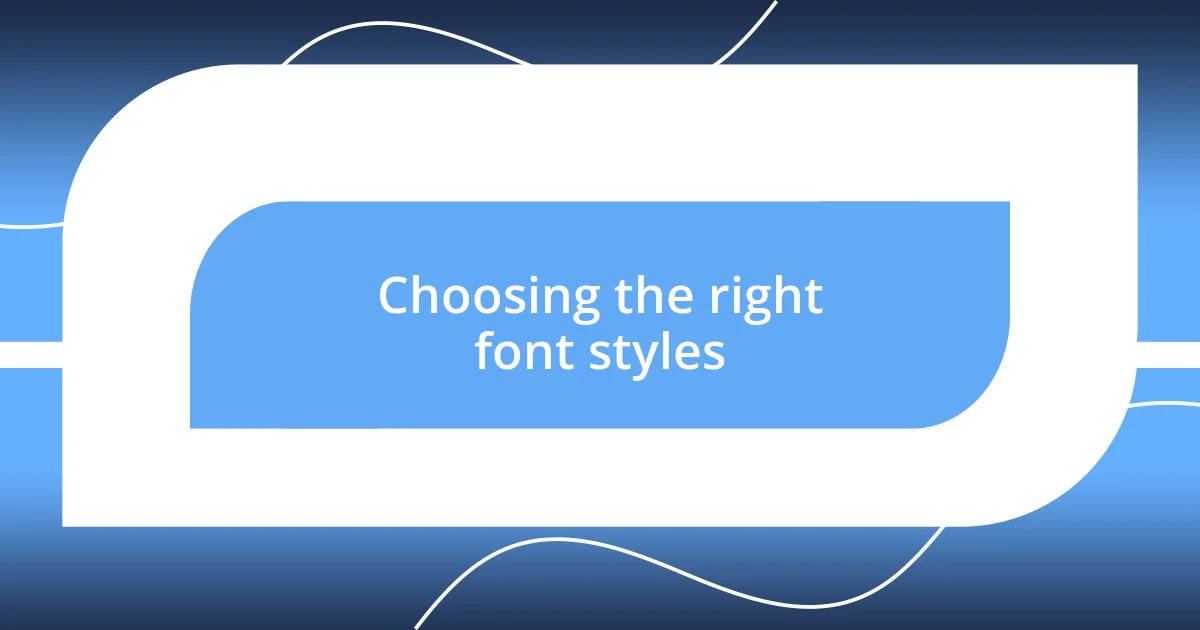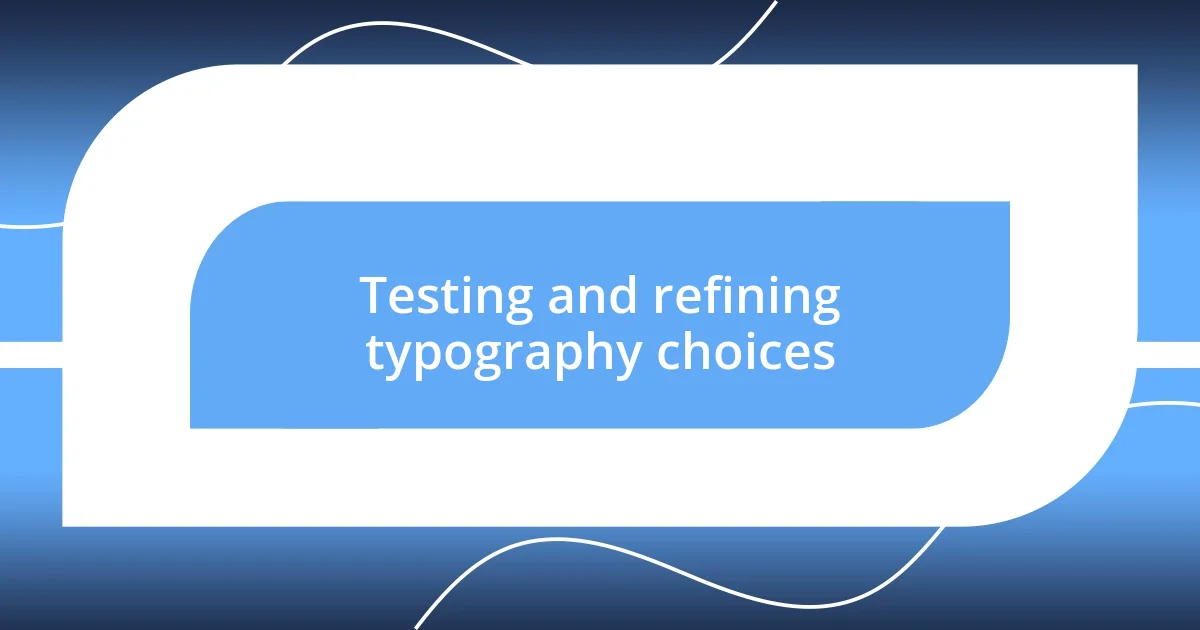Key takeaways:
- Understanding typography fundamentals, including kerning, leading, and hierarchy, significantly enhances communication and design effectiveness.
- Choosing the right font styles involves considerations such as purpose, readability, compatibility, emotion, and consistency to effectively convey the intended message.
- Implementing responsive typography and actively testing choices ensures accessibility and engagement across devices, allowing for continuous improvement based on feedback.

Understanding typography fundamentals
Typography is more than just choosing a font; it’s about the emotion and clarity that each typeface conveys. I remember the first time I experimented with different fonts for a personal project. I discovered how a playful script could evoke joy while a bold sans-serif felt commanding. Isn’t it fascinating how a simple change can completely shift the mood of a design?
Understanding the basics like kerning, leading, and hierarchy can dramatically improve your typography skills. Kerning, which refers to the spacing between individual letters, can make a word feel more cohesive or totally disjointed. I once realized that poor kerning in a poster made my message muddled, and that discovery was a game changer for me. Have you ever noticed how a little space can breathe life into a design?
Choosing typefaces that complement each other is also fundamental in typography. It’s like creating a harmonious relationship; one font should support the other without overshadowing it. I recall feeling victorious after pairing a serif and a sans-serif font for a presentation—it transformed the whole look! Isn’t it delightful when a simple combination elevates your work and enhances communication?

Choosing the right font styles
Selecting the right font styles is crucial because it sets the tone for your entire project. I vividly remember a time when I mistakenly chose an overly ornate font for a professional email. It felt wrong. The elegant style, while beautiful, diluted my message. That experience taught me to prioritize clarity and context when I choose fonts. A font should enhance your message, not distract from it.
Here are some key considerations for choosing the right font styles:
- Purpose: Understand the message and audience. A playful font might be perfect for a children’s event, but not for a corporate report.
- Readability: Ensure that your font is easy to read. I often test fonts at various sizes to see how they perform—especially in long paragraphs.
- Compatibility: Experiment with pairs. I once paired a modern sans-serif with a classic serif, creating a beautiful balance that felt inviting yet professional.
- Emotion: Think about the feelings you want to evoke. A casual script can convey warmth, while a clean sans-serif can inspire trust.
- Consistency: Stick to a limited number of typefaces to keep a cohesive look. I find that using two or three fonts maximizes impact without overwhelming viewers.

Establishing a typography hierarchy
Establishing a typography hierarchy is essential for guiding the reader’s eye through your content. When I first started designing, I naively presented all my text in a similar style, which led to a confusing experience for my audience. I learned that using different sizes, weights, and styles not only helps emphasize important information but also creates a visually pleasing flow that keeps readers engaged. Have you ever struggled to find the key points in a wall of text?
In addition to size and weight, differentiating headings from body text plays a critical role in hierarchy. I vividly remember revamping a blog layout; by adjusting the heading size and incorporating bold weights, I instantly made it easier for readers to skim the article. This approach not only enhanced user experience but also encouraged more people to dive into the content. By establishing clear categories, you turn dense information into digestible chunks.
To further illustrate this, consider the contrast between a clearly defined hierarchy versus a flat one. A well-structured layout leads to efficient communication, while a chaotic one leaves readers feeling lost. In my experience, embracing this hierarchy transformed my communication style. I now think of typography as my ally in storytelling, effortlessly conveying importance and context through visual cues.
| Typography Hierarchy | Flat Typography |
|---|---|
| Dynamic engagement and clarity | Confusing and overwhelming |
| Clear headings and subheadings | No distinction in text styles |
| Guided reader navigation | Readers struggle to find key points |
| Effective communication | Message gets lost in the noise |

Creating effective line spacing
Creating effective line spacing is a subtle yet vital aspect of typography that can vastly improve readability. In my journey as a designer, I encountered a project where the text felt so cramped that it strained the reader’s eyes. I decided to adjust the line spacing, or leading, and immediately noticed an improvement. I always aim for a balance; too little spacing can suffocate the text, while too much can disconnect it.
One thing I like to consider is the font size when setting line spacing. For example, in a recent article, I used a font size of 16px and opted for a line height of 1.5em. The difference was remarkable! This little tweak made the text flow better and feel inviting. Have you ever read something that felt just right? That’s the kind of experience I strive for.
It’s also important to think about the context in which your text appears. I learned the hard way that different formats require different approaches. For instance, in a digital layout, tighter line spacing may be acceptable, but for print, a more generous spacing can enhance the reading experience. Engaging with your audience means considering how they consume your content. It’s about creating comfort. When readers can focus on your message without distraction, that’s when typography truly shines.

Utilizing contrast for readability
Utilizing contrast in typography is essential for enhancing readability and drawing attention to key elements. I remember one instance when I was designing a marketing brochure. Initially, the text was all in a dark gray, which made the content feel flat. By introducing a bright white background with darker, bolder text, I discovered how contrast could automatically lift the overall design. It was like flipping a switch—suddenly, the information felt accessible and engaging.
When I think about contrast, I reflect on the emotional impact it has on the reader. Have you ever stumbled upon a beautifully designed website that just pulls you in? That’s often due to effective contrast. I’ve learned that pairing different colors or weights can emphasize important messages and guide readers’ focus. For instance, using a bold color for headings while keeping body text subtle creates a dynamic visual experience that invites people to explore more.
Another aspect I discovered is the interplay between text and background—a lesson I picked up after attending a design workshop. There, I experimented with various combinations, finding that a light pastel background could beautifully highlight dark text without overwhelming the reader. The lesson was clear: contrast is not just a design choice; it’s a tool that shapes the reader’s journey. What contrast techniques have you tried, and how did they change your approach to typography?

Implementing responsive typography
When diving into responsive typography, I’ve found that flexibility is key. In a recent web project, I realized how different devices can change the reading experience entirely. When I initially set my font size and line height, everything looked great on my laptop, but on mobile, it was a different story. Adjusting those parameters for different screen sizes was crucial; I ended up embracing CSS media queries to make those changes effortlessly. It’s satisfying to see text not just resize but also retain its charm across devices.
One of my favorite strategies is using relative units like ems and percentages instead of fixed pixels. This approach allows text to scale beautifully based on user settings. I remember adjusting a website’s typography for a client with visual impairments. By implementing responsive units, their users could enlarge the text effortlessly, enhancing accessibility. Can you think of a time when you realized that small adjustments made all the difference for someone?
Moreover, I’ve experimented with fluid typography, which offers an exciting way to blend design and functionality. I once tried a setup where the font size changed seamlessly based on the viewport width. It was a bit of a challenge at first, but watching the text adapt in real time was exhilarating. This experience taught me that typography isn’t just about aesthetics; it’s also about creating an intimate connection between the content and the reader. Have you ever experienced the joy of seeing your design come alive through typography? Knowing that our choices can make such a difference feels incredibly rewarding.

Testing and refining typography choices
Testing and refining typography is a continuous journey that I love to embark upon. I recall a project where I thought I nailed the font choice, but after getting feedback from the team, I realized the serif typeface I picked was causing confusion. The subtle curves, while elegant, couldn’t compete with sans-serif alternatives in terms of clarity. So, I quickly made the switch, and it felt like shedding a weight; suddenly, the text danced off the page and drew the reader in effortlessly.
During the testing phase, I like to conduct A/B tests, especially when I’m experimenting with different typographic hierarchy setups. I remember once using two layouts for a newsletter: one with a bold headline and the other with a lighter touch. The results were eye-opening! The bold version captured more engagement, but there was a good deal of hesitation over the softer approach, too. I find it fascinating how readers can react to different presentations of the same content—what did I do right? What could be improved? It’s in those nuances that I see the potential for enhancing communication.
Iterating on typography can also feel a bit like a personal dialogue with the audience. After receiving constructive feedback on font weight and spacing, I had an epiphany about legibility—that less can indeed be more. I made a conscious decision to simplify one of my designs, stripping it down to a single typeface with varying weights. The transformation was amazing! It reminded me that typography isn’t just a visual element; it’s a way to speak to readers without saying a word. Have you ever been surprised by how much a simple tweak in typography could transform your message?














